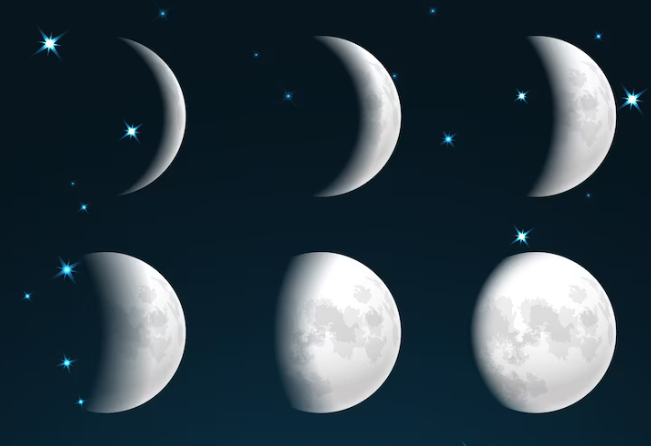Joining an old-fashioned stargazing group is remarkably similar to playing Google’s Moon Game, but with an alluring contemporary twist. The idea is charmingly straightforward but deceptively difficult: battle the Half Moon by correctly connecting the lunar cycle’s phases more precisely than your cosmic adversary. Instead of just tapping cards, players must think about the moon’s subtle changes, connect well-known objects to scientific names, and race against the clock to get their hands on rare wildcards.
The game, which was released to commemorate the last Half Moon in October, has a lighthearted yet reflective vibe. Notably, Google’s design team capitalized on people’s natural curiosity about space by gamifying it into an unexpectedly intimate experience. The player connects fragments of the moon’s journey—from a waxing crescent to a glowing full—and learns without even realizing it, much like discovering constellations concealed among a spray of stars. The way that every victory feels so well-deserved—almost as if it were the result of a covert competition against the skies themselves—is especially inventive.
| Attribute | Details |
|---|---|
| Game Name | Google Moon Game |
| Theme | Space Education, Gamified Lunar Exploration |
| Launch Timing | October Half Moon |
| Developer | Google Doodle Team |
| Gameplay Focus | Match lunar phases, earn points, unlock wildcards |
| Special Seasonal Themes | Wolf Moon (January), Long Night Moon (December) |
| Official Link | Google Doodles Archive |
| Audience | Casual gamers, astronomy enthusiasts, students |
| Purpose | Raise lunar awareness, celebrate celestial events |
| Impact | Educational entertainment, space curiosity revival |
As players explore the Moon Game further, they find that its mechanics have a strong astronomical foundation. For example, the so-called “Half Moon” is actually a quarter moon, which is only a quarter illuminated but is misinterpreted by the general public. This balance between colloquial language and scientific precision teaches significantly without offending anyone. This deliberate balance, which is consistent with Google’s best Doodle projects, makes the game feel incredibly clear and unpretentious.

Players observed that Google increased the ambiance with cozier, darker boards, especially during the Long Night Moon event in December. Each new level felt like a small, reflective journey thanks to layered animations that depicted winter skies and gently drifting snow. Likewise, at the January Wolf Moon event, the game ingeniously urged players to “join the pack,” fostering a sense of community that was surprisingly genuine and evocative of old-fashioned winter get-togethers beneath a bright full moon.
It is impossible to avoid making comparisons to more general cultural trends. The public’s imagination has gradually returned to space in recent years. Space exploration feels tangible once more with NASA’s Artemis project, which aims to create a permanent human presence on the Moon, and Elon Musk‘s Starship aspirations, which are stoking interplanetary dreams. Despite its lightheartedness, Google’s Moon Game is a great example of this expanding social trend, encouraging curiosity through play rather than technical jargon.
It’s interesting to note that celebrities have also embraced this moon craze. A screenshot of her wildcard collection was shared by actress Zendaya during the January event, with the caption, “phases of my life right now,” which skillfully combined relatability and humor. Similarly, after a difficult day, musician Finneas tweeted that beating the Moon was “strangely satisfying”—a sentiment that many people subtly shared on social media. Despite being informal, their support helped the game become a hot topic, greatly expanding its audience.
The Google Moon Game uses interactive storytelling to tell a story in which players unconsciously take on the role of amateur astronomers. Players are gently encouraged to think beyond gaming with every card flip and point scored—to look up, to wonder, to learn. It is especially helpful because it promotes a deeper understanding of lunar science without using overbearing teaching methods, which is something that many conventional teaching approaches find difficult to accomplish.
The educational gaming industry has seen a boom in recent months, and Google’s Moon Game is a particularly successful case study. Google’s Moon Game subtly gamifies astronomy in the same way that Duolingo did with language learning. It draws attention to a change in which education and entertainment no longer stand on opposite poles but rather increasingly coexist and provide fulfilling and illuminating experiences.
Through the incorporation of visual cues that mimic actual lunar progression, such as dimming gibbous phases and brightening crescents, the game offers a highly adaptable experience for players of all ages. The game encourages participation in a remarkably inclusive way, whether it’s a retired professor experiencing a wave of nostalgia while remembering lectures in the classroom or an inquisitive child making their first connections.
It’s also important to recognize the emotional impact of competing against the Moon. A straightforward reminder of the Moon’s consistent cycle provides an oddly reassuring experience in a fast-paced, digital age where everything seems to be ephemeral. Players are reconnected, albeit momentarily, to a universal rhythm that has marked the passage of time for millennia through each victory and defeat.
In the future, Google’s Moon Game might serve as the model for a whole new generation of digital experiences with a celestial theme. Future additions might include asteroid belts, Mars phases, or even virtual meteor showers through partnerships with scientific organizations, greatly enhancing the educational value. Such initiatives could significantly connect public understanding with future scientific endeavors, especially in light of the growing interest in private space exploration.